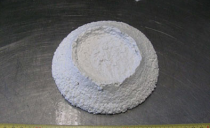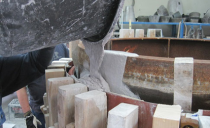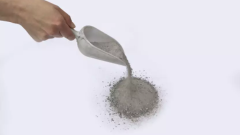
What Are the Best Refractory Linings for Induction Furnaces?
Choosing the right refractory linings for your induction furnace is crucial for consistent product quality, longer maintenance cycles, and plant energy savings. But with all the different lining materials on the market, how do you decide which one best suits your products and budget?
First, let’s touch on the basics of induction furnaces.
What Is an Induction Furnace?
These come in two main designs: core type and coreless1.
They use magnetic coil induction to heat ferrous and non-ferrous metals quickly and evenly in a crucible or channel for pouring. An alternating current is passed through the primary copper coil surrounding a central chamber that contains the metal to be melted (charge), creating an alternating magnetic field. The resultant eddy currents meet resistance, generating heat (the Joule effect) that quickly melts and stirs the metal2.
Advantages of Induction Furnaces
- Suit a wide variety of metals, quickly switch on and off, and come in various capacities (a few kilograms to several tons).
- Save energy and emit less CO2 than electric arc furnaces, improving your plant’s sustainability.
- Enable precise temperature control to attain the desired properties of specific pure metals and alloys with minimal losses.
- No gas to contaminate the metal.
- Much quieter, no exposed electrodes, reduced risk of arc flashes.
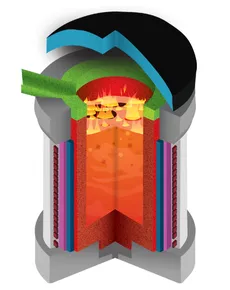
What Different Linings and Materials Do Induction Furnaces Contain?
Refractory bricks aren’t suitable because the joints create weak points that may fail under high mechanical loads and thermal expansion.
Instead, monolithic refractory linings are used, which include ramming mixes, castables, and plastic refractories that are easy to install, repair, and replace4.
Saint-Gobain offers a range induction furnace lining materials perfectly suited to foundry environments: the NorvibeTM, NorcoilTM, and NortopTM mixes.
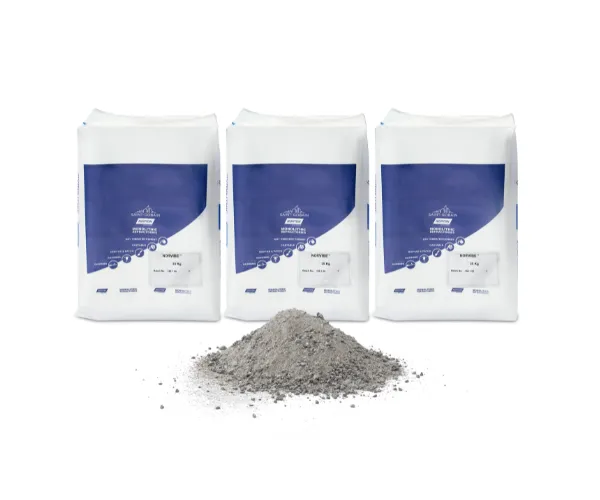
NorvibeTM is a dry vibrated cement (DVC) for working linings of the chamber and spout, based on high quality raw materials:
- Mechanical strength withstands thermal shock operating conditions.
- Resists corrosion by slag and reactive metals.
- Formulations suit all types of metals: iron, steel, special alloy, copper/brass, zinc, aluminum.
- Thermodynamic properties can reduce CO2 emissions by up to 5% vs. silica-based refractory linings.
NorcoilTM is a coil cement for coreless induction furnaces, dedicated to/for:
- Protects the coil from puncture by molten metal while promoting optimal heat transfer, and holds the coil in position.
- Highly resistant to vibration and effects of high electrical frequency, such as electrical breakdown and arcing.
- Easy to handle and install, with convenient setting and drying times.
- A tailored solution for any metal: iron, steel, special alloy, copper/brass, zinc, aluminum.
NortopTM mixes provide high thermal resistance solutions to protect surface zones:
- Toping linings of coreless furnaces to protect from heavy loads.
- Surface finishing for inductors to enable good junctions between upper and inductor preventing further leackage.
- Available in a range of formulations depending on the metal/alloy handled.
- The adjusted bonding system ensure that mechanical strength and performance all along the furnace campaign.
Quick Repairs and Maintenance:
For fast hot or cold repairs to cracks or worn areas repairs, we provide a full set of solutions through our NorplastTM, NorfixTM solutions following customized practices (hand trowel and pneumatic tools).
Refractory Linings from Saint-Gobain
Saint-Gobain will help you choose the right refractory linings for safe, consistent, efficient, and sustainable operation—so you can satisfy your customers’ needs while protecting your furnace and saving money, energy, emissions, and time.
NORVIBE® Dry Vibrated Cements Case Study
Challenge: cements can be made with high-quality, pure raw materials that are engineered to achieve maximum performance
Castables
Saint-Gobain Performance Ceramics and Refractories' castables range is not limited to regular cement content but also specialties such as self-flowing or...
